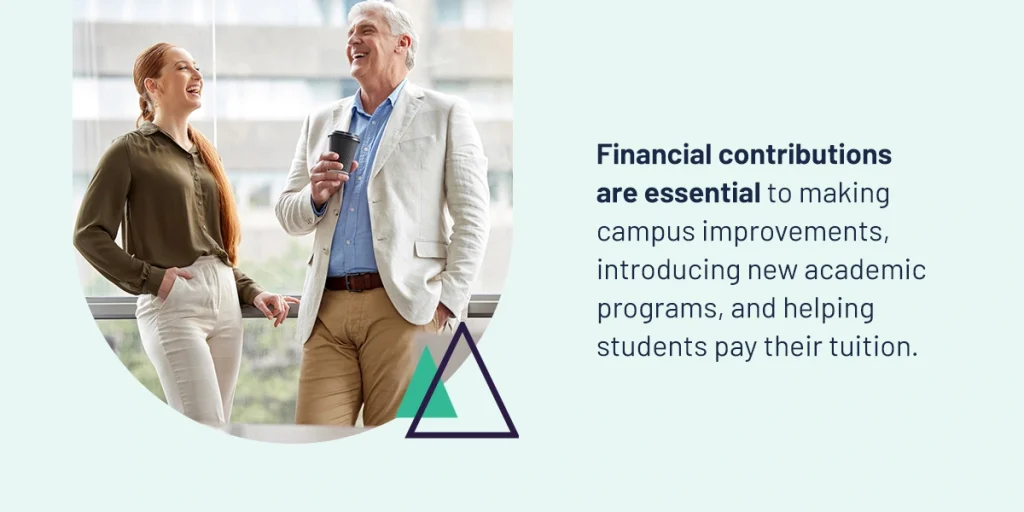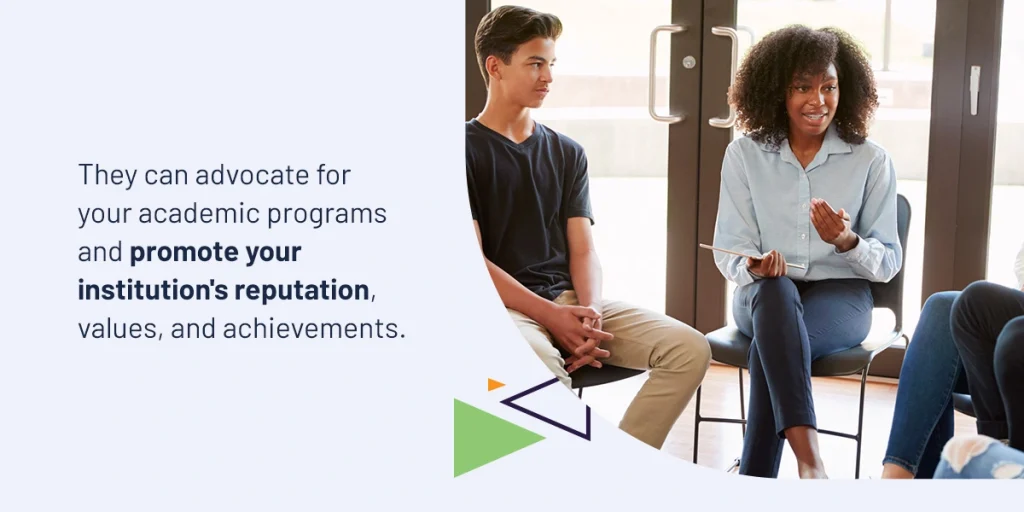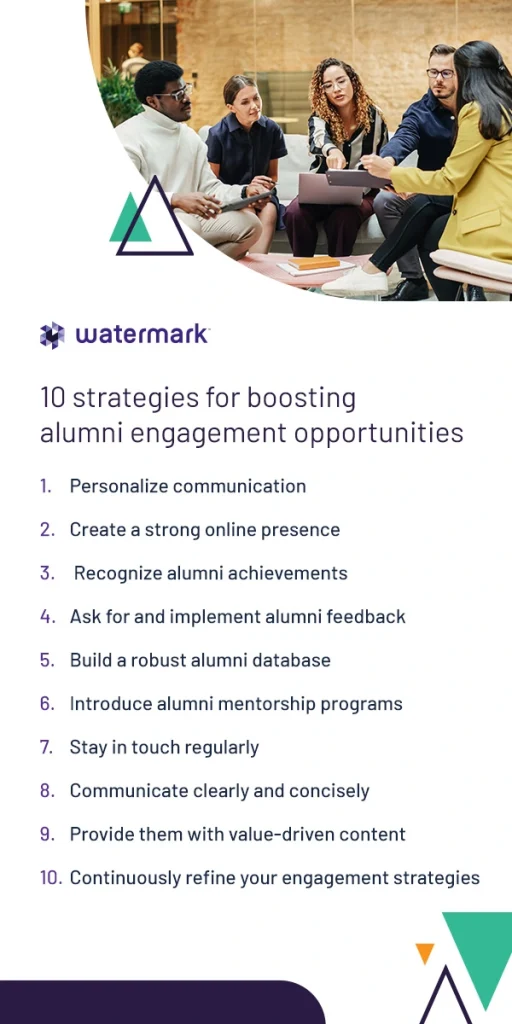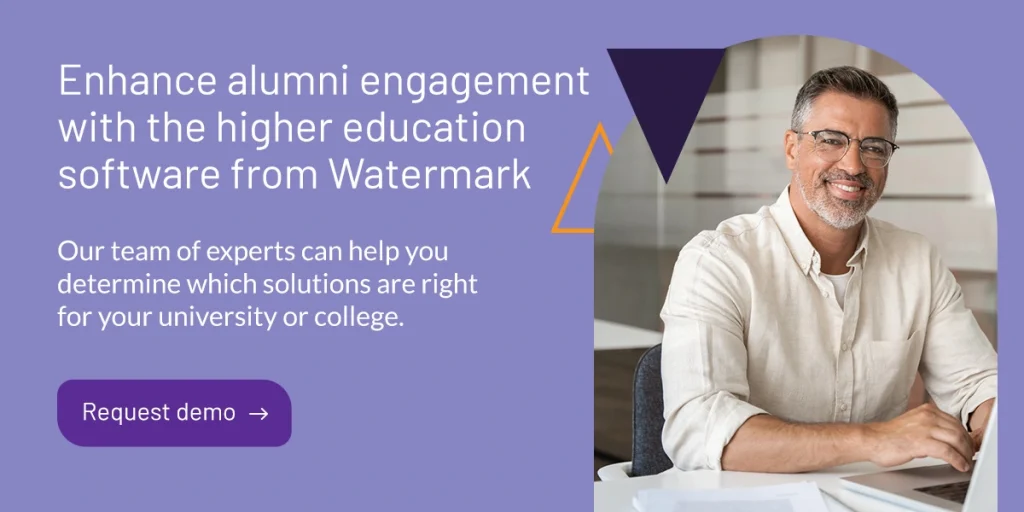




Alumni engagement can have a massive influence on the growth and success of your higher education institution. Your graduates are a reflection of your college or university, and their continued involvement with campus happenings can inspire loyalty, dedication, and pride in your current student body.
Luckily, the latest technology and data advancements make connecting with alumni easier than ever. Institutions like yours can stay in touch with former students and foster mutually beneficial relationships that last a lifetime. We are breaking down 10 different strategies for engaging your alumni community and enhancing these connections for the long-term success of your institution.
Your higher education institution’s alumni play a significant role in your community. Explore some of the key reasons why they are so integral to success below:
A college or university’s relationship with its students does not end on graduation day. Keeping alumni engaged helps your institution maintain long-term connections that are rooted in loyalty and school spirit.
Staying connected with your former students is important for your current learners to see and experience. Alumni are an invaluable resource for your school — they show your students what is possible with a degree from your institution, and they set the foundation for future student success.
Another reason why alumni engagement is critical for higher education institutions is their financial contributions. Graduates are often leading donors to colleges and universities, and staying connected with your former students is a great way to ensure you keep these dollars coming.

Financial contributions are essential to making campus improvements, introducing new academic programs, and helping students pay their tuition. In fact, 46 percent of higher education donors say they give their hard-earned money to make school more affordable for current students.
Alumni engagement is also essential for providing students with the most robust mentorship and networking opportunities possible. No one understands what it is like to be in each current student’s shoes more than someone who has completed their degree program, received their diploma, and successfully entered the workforce from your institution.
Your college or university’s alumni can offer valuable guidance and support for your students, sharing their expert insight into various career paths and industries.

By engaging your alumni and continuously reminding them of their important role in your institution’s culture, your school can inspire former students to act as powerful ambassadors for your college or university. They can advocate for your academic programs and promote your institution’s reputation, values, and achievements.
Your institution can engage and give back to its alumni by hosting special events geared toward networking, continuous education, and professional opportunities. By offering value to your former students, you can inspire them to take action and get involved in your community and campus.
Having a strong, engaged alumni community is highly beneficial for higher education institutions. Alumni relations are especially important because the attitudes of former students have a huge impact on your school’s reputation. Proud alumni want to support and give back to their alma mater. Their achievement and professional success are a testament to your academic programs and the quality of your curricula. Alumni endorsement is integral to long-term, sustainable growth.
The digital age is here to stay, and technology is one of the most powerful tools your higher education institution has to engage your alumni community. Don’t miss out on the opportunities to keep in touch with your graduates and establish lifelong relationships with them.
In the past, sharing information and updates with your school’s alumni via traditional mail could be ineffective in boosting engagement. If alumni do not update their addresses, your institution could lose touch very easily. Now, you can communicate directly with former students through email, text, and social media. On average, Americans check the notifications on their phone 144 times per day, making it easier than ever to connect with your alumni and increase the likelihood they see your message.
Technology also makes it possible to collect and utilize alumni data. Your institution can use these insights to inform decision-making and leverage automation. These tools allow you to take a more tailored approach to communicating with and engaging your students.
Advancing technologies are making it easier and more effective than ever to maintain relationships with your alumni and strengthen this important community.
Higher education institutions can reap endless benefits from having engaged alumni, from more networking opportunities for current students to greater financial support to better recruitment efforts. Understanding how to communicate with your former students in a way that inspires action and motivates them to remain an active member of your institution.
Explore the following strategies for enhancing alumni engagement below:

Personalizing alumni communications can help your institution increase the likelihood that your message captures the attention of your recipients.
When sharing emails or texts with your alumni, consider using data to segment your audience. You can send messages to particular groups, such as former student-athletes, English majors, or people who have attended other alumni events.
Segmentation allows your institution to share relevant information with the right people, making them more inclined to engage. It also allows you to establish a stronger emotional connection with your graduates by demonstrating your college or university’s attention to detail. Nostalgia can also be a wonderful tool for evoking a response from your alumni and keeping them in the know.
Personalized messages tend to yield higher response rates than generic communication that a person is likely to overlook.
Establishing a strong online presence is an essential strategy for modern higher education institutions. Your digital channels, including your website and social media accounts, should be easily accessible and updated. These are great avenues of communication for your college or university.
Having a solid digital presence makes it easier for former students to stay updated on campus happenings and get in touch with your alumni association in seconds. Your institution can utilize different platforms to share relevant news or information about upcoming events. These online channels also make it possible to share valuable resources, including the following, directly with your alumni:
Your college or university can ultimately leverage its online accounts to stay top of mind for alumni.
Recognizing alumni success stories and achievements is crucial to boosting engagement. By actively acknowledging and celebrating their wins publicly, you can strengthen your institution’s relationships with its graduates and demonstrate your long-term commitment to student growth.
In spotlighting different alumni and their work, you invite diverse individuals to engage with your events and give back. It is a valuable part of community building. Those who feel recognized and uplifted by their alma mater will be more likely to participate in campus events and stay connected.
Pointing out your alumni’s successes is also a beneficial strategy for improving donor relations. Alumni who feel honored and valued by your college or university will be more likely to support your institution financially through donations and volunteering initiatives.
A great way to enhance alumni engagement is to request honest feedback from them. Ensure you highlight how much your institution values their input and unique perspectives.
Seeking feedback is a simple but effective way to demonstrate your institution’s commitment to continuous improvement while inviting your students to share how they think you could be doing better. They are your target audience, and their experiences matter.
You can even ask your graduates for ideas on how to boost engagement and make alumni events more enticing for former students. Make it easy for your alumni by sharing surveys that they can respond to from the convenience of their mobile devices. Use the insights you gain from their feedback to take a more strategic approach to engagement.
Your higher education institution can also support increased engagement by building and maintaining a robust alumni database. Keeping track of each graduate’s contact information lets your college or university:
This information can help your institution inform and enhance engagement initiatives with a greater understanding of alumni needs, preferences, and satisfaction levels. A comprehensive student database can also be an invaluable tool for promoting upcoming events, opportunities, and programs across campus.
Another way to increase alumni engagement is to introduce mentorship programs. You can invite your entire alumni community to participate or hand-pick a few different individuals across various departments for these roles.
By creating a professional development program, you invite former students to bring their expertise and working experience back to their roots. Offering guidance to current students is a full-circle moment for many alumni, allowing them to return to the place where they set their careers in motion.
Don’t be afraid to highlight the value that your institution’s alumni receive from these programs to encourage them to participate. Mentorship is a great way to facilitate networking opportunities. For graduates looking for new hires, being part of a program with their alma mater is a great way to source new talent.
One key to fostering better alumni engagement is to prioritize consistent communication. Reaching out to your alumni community here and there will not inspire interest and participation. Instead, share regular updates with your graduates to stay top of mind.
Sending monthly newsletters is a simple way to stay in touch with former students. You can use this as a routine opportunity to invite them to upcoming events and share the latest happenings across campus. Some ideas of messages to share include:
Sending information on various platforms is a great way to maximize your higher education institution’s reach. Sharing posts, emails, and texts will help your college or university meet alumni where they are, ultimately increasing engagement.
Ensure your institution prioritizes clear, concise communication with your alumni. Being too wordy or sharing too much information will bore readers, and they will be less likely to open your next message. Get to the point quickly and be straightforward about the purpose of each text, email, or social media post.
Include a clear call to action (CTA) if you want your alumni to do something specific, like sign up to be a mentor or make a donation on your institution’s website. Be direct and keep the CTA simple so the reader feels motivated. The key is to avoid confusion and eliminate ambiguity that could result in disengagement.
Share short, memorable messages that demonstrate your college or university’s respect for your alumni’s limited time and energy.
When communicating with your alumni, ensure your institution is not repeatedly encouraging donations. Mixing in value-driven content is essential for optimizing engagement. Be sure you are sharing information that is relevant and valuable to the reader, such as new job opportunities, promotions, and career networking resources.
Your institution should continuously deliver value and give alumni many reasons to keep reading your college or university’s messages. Before sharing a text, email, or post with your community, have your team ask themselves why the reader would find the information useful or relevant.
Providing value-driven content also builds additional credibility and trust with your alumni, which is essential for maintaining active, ongoing alumni relationships that benefit your institution and graduates alike.
Our final strategy for enhancing your alumni engagement opportunities is committing to continuous improvement. As your institution tests different engagement initiatives, you can benefit from assessing the success of each one and identifying opportunities for growth.
Technology and how we communicate is always evolving. Adapting your strategies to suit the unique preferences of your alumni will help your college or university find new ways to stay relevant and connected in the busy digital world. In carefully analyzing what is and is not working for your institution, you can effectively avoid putting time, money, and energy into alumni projects that aren’t delivering enough value to your institution, students or graduates.
Your school can use these insights to create newer, more robust engagement strategies that actually work in resonating and connecting with your alumni community.
If your higher education institution is looking to enhance alumni engagement and empower continuous improvement across campus, turn to the solutions from Watermark.
Our platform includes various products designed to help institutions like yours drive decision-making with data-backed insights and the power of automation. Our team of experts can help you determine which solutions are right for your university or college. We want to help streamline communication with your alumni and inspire them to stay in the know about the latest on campus.
Request a demo of the higher education software from Watermark to get started today.






























































































































































































































































































































































































